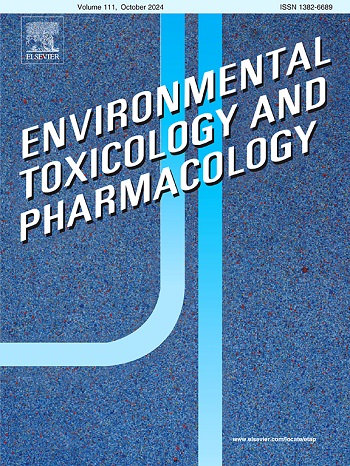二恶英和多氯联苯对秀丽隐杆线虫早期生命发育的影响
IF 4.2
3区 环境科学与生态学
Q2 ENVIRONMENTAL SCIENCES
引用次数: 0
摘要
本研究评估了三氯二苯并对二噁英、两种多氯联苯混合物(Clophen A50 和 Aroclor 1254)以及来自海洋沉积物和游蟹组织的现场提取物对草履虫早期发育的影响。雌线虫暴露在琼脂上,分离出的卵和幼虫在溶液中进行测试。72 小时后评估幼虫的发育情况。报告基因检测法(DR-CALUX)也用于量化二恶英当量毒性(TEQ)。在琼脂上暴露于 10 pM Clophen A50 和 TCDD 会分别抑制 L3-L4 过渡 60 % 和 50 %。液体接触 5 µM Aroclor 1254 或 TCDD(10 nM 和 10 µM)会使发育延迟 20-40%。野外提取物的毒性当量值为 0.67-4.91 纳克/千克(0.2-1.47 pM TCDD),使 L3-L4 的发育减少 40-60%。这两种生物测定方法都能有效评估环境样本中持久性有机污染物的毒性。琼脂暴露模拟了真实的吸收,而液体检测则提供了更快的高通量筛选。本文章由计算机程序翻译,如有差异,请以英文原文为准。
Early life developmental effects induced by dioxins and PCBs in novel bioassays with C. elegans
This study assessed the effects of TCDD, two PCB mixtures (Clophen A50 and Aroclor 1254), and field extracts from marine sediments and swimming crab tissues on early-life development in Caenorhabditis elegans. Gravid nematodes were exposed on agar, and isolated eggs and larvae were tested in solution. Larval development was evaluated after 72 hours. Reporter gene assays (DR-CALUX) were also used to quantify dioxin-equivalent toxicity (TEQ). Exposure to 10 pM Clophen A50 and TCDD on agar inhibited L3–L4 transition by 60 % and 50 %, respectively. Liquid exposure to 5 µM Aroclor 1254 or TCDD (10 nM and 10 µM) delayed development by 20–40 %. Field extracts contained TEQ values of 0.67–4.91 ng/kg (0.2–1.47 pM TCDD), reducing L3–L4 development by 40–60 %. Both bioassays effectively assessed the toxicity of persistent organic pollutants in environmental samples. Agar exposure mimics realistic uptake, while liquid assays offer faster, high-throughput screening.
求助全文
通过发布文献求助,成功后即可免费获取论文全文。
去求助
来源期刊
CiteScore
7.00
自引率
4.70%
发文量
185
审稿时长
34 days
期刊介绍:
Environmental Toxicology and Pharmacology publishes the results of studies concerning toxic and pharmacological effects of (human and veterinary) drugs and of environmental contaminants in animals and man.
Areas of special interest are: molecular mechanisms of toxicity, biotransformation and toxicokinetics (including toxicokinetic modelling), molecular, biochemical and physiological mechanisms explaining differences in sensitivity between species and individuals, the characterisation of pathophysiological models and mechanisms involved in the development of effects and the identification of biological markers that can be used to study exposure and effects in man and animals.
In addition to full length papers, short communications, full-length reviews and mini-reviews, Environmental Toxicology and Pharmacology will publish in depth assessments of special problem areas. The latter publications may exceed the length of a full length paper three to fourfold. A basic requirement is that the assessments are made under the auspices of international groups of leading experts in the fields concerned. The information examined may either consist of data that were already published, or of new data that were obtained within the framework of collaborative research programmes. Provision is also made for the acceptance of minireviews on (classes of) compounds, toxicities or mechanisms, debating recent advances in rapidly developing fields that fall within the scope of the journal.

 求助内容:
求助内容: 应助结果提醒方式:
应助结果提醒方式:


